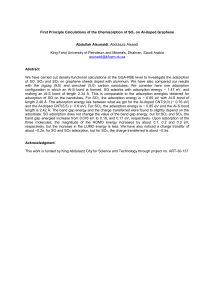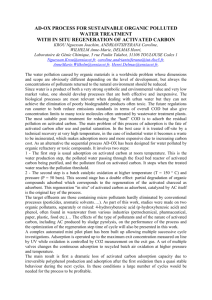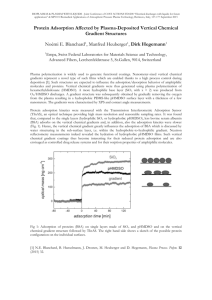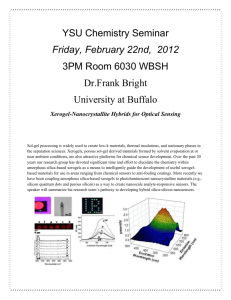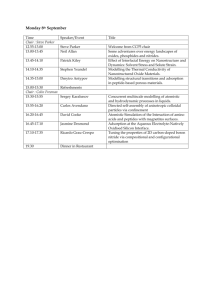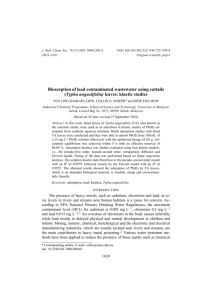S.1. Synthesis of resorcinol-formaldehyde xerogels
advertisement
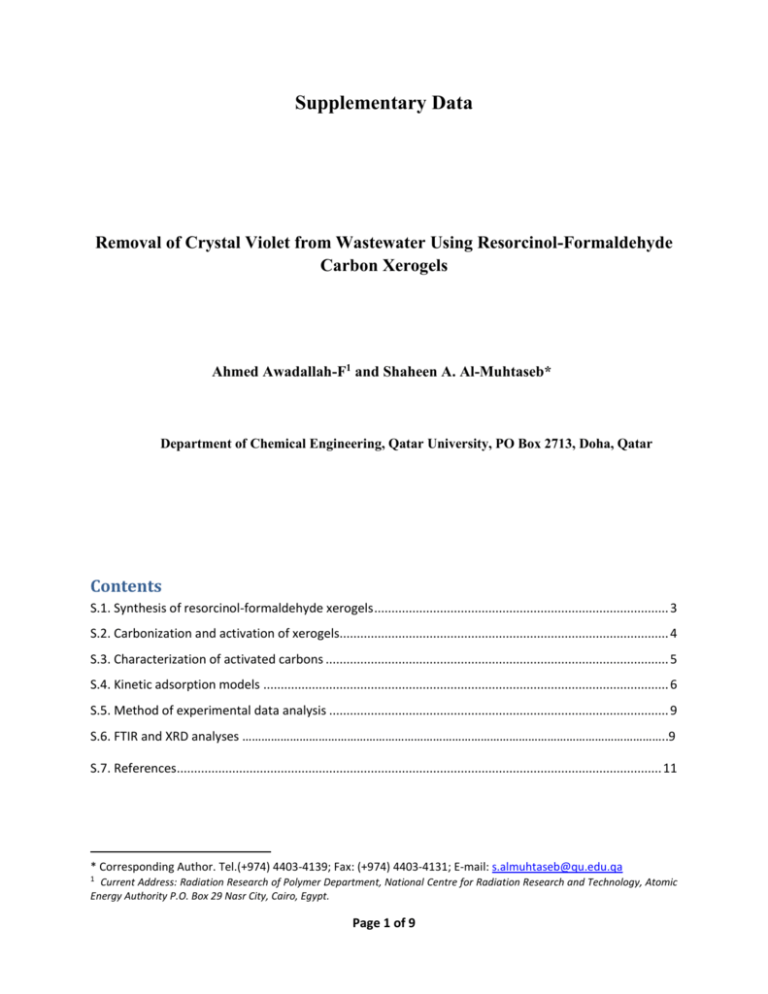
Supplementary Data Removal of Crystal Violet from Wastewater Using Resorcinol-Formaldehyde Carbon Xerogels Ahmed Awadallah-F1 and Shaheen A. Al-Muhtaseb*1 Department of Chemical Engineering, Qatar University, PO Box 2713, Doha, Qatar Contents S.1. Synthesis of resorcinol-formaldehyde xerogels ..................................................................................... 3 S.2. Carbonization and activation of xerogels............................................................................................... 4 S.3. Characterization of activated carbons ................................................................................................... 5 S.4. Kinetic adsorption models ..................................................................................................................... 6 S.5. Method of experimental data analysis .................................................................................................. 9 S.6. FTIR and XRD analyses ……………………………………………………………………………………………………………………..9 S.7. References............................................................................................................................................ 11 * Corresponding Author. Tel.(+974) 4403-4139; Fax: (+974) 4403-4131; E-mail: s.almuhtaseb@qu.edu.qa 1 Current Address: Radiation Research of Polymer Department, National Centre for Radiation Research and Technology, Atomic Energy Authority P.O. Box 29 Nasr City, Cairo, Egypt. Page 1 of 9 Page 2 of 9 S.1. Synthesis of resorcinol-formaldehyde xerogels Xerogels were prepared with a fixed recipe consisting of a resorcinol to formaldehyde molar ratio of 0.5, resorcinol to water molar ratio of 0.05, and resorcinol to catalyst molar ratio of 500. However, the initial solution pH values were fixed for different samples in the range from 1.0 to 7.0. The prepared samples were coded as S-1 (prepared at pH = 1.0); S-2.5 (prepared at pH = 2.5); S-4 (prepared at pH =4.0); S-5.5 (prepared at pH = 5.5) and S-7 (prepared at pH = 7.0). Resorcinol and sodium carbonate were weighted and mixed with ultrapure water in Erlenmeyer flasks and then stirred magnetically until all resorcinol and sodium carbonate are completely dissolved. Then, the specified amount of formaldehyde solution was added to the dissolved ingredients. After that, the solution pH level was adjusted to the desired value by using diluted nitric acid and ammonium hydroxide solutions. Resorcinol-formaldehyde (RF) solutions were then poured into polypropylene vials, sealed and placed in an oven at 70 ± 1 °C for 7 days. In order to prevent the dehydration of the gels and to increase their cross-linking, 2% acetic acid was poured upon the gels surfaces after their solidification and the gel was continuously observed to prevent its dryness. Then, the vials were removed from the oven and allowed to cool to room temperature. The remnant solutions above the cured gels were then decanted and exchanged with acetone at room temperature. The samples were left in acetone at room temperature, and the remaining acetone is replaced with fresh acetone daily for 3 days. After the third day of solvent exchange, the cured gels (with the accompanying fresh acetone) were placed in an oven at 50 ± 1°C, and kept for 2 days to dry at that condition [1]. Page 3 of 9 S.2. Carbonization and activation of xerogels Each dried RF xerogel was placed in a ceramic boat inside a programmable electric-heated tube furnace (Nabertherm GmbH), with a continuous flow of nitrogen (100 cm3min-1). The furnace was first maintained at room temperature for 30 min to make sure that the air is completely purged with the flowing nitrogen. Then, the furnace was heated up to a temperature of 773 K with a heating rate of 10 Kmin-1. The sample was maintained at 773 K for 3 h, and then allowed to cool to room temperature while passing nitrogen. The resulting carbon xerogel was then activated in the same tube furnace with CO2 flow (150 cm3min-1) instead of nitrogen, heating the sample again with a rate of 10 K min-1 to 973 K, maintaining this temperature for 1 h, and then allowing the sample to cool down to room temperature while passing CO2. Page 4 of 9 S.3. Characterization of activated carbons The pore structure of the resorcinol-formaldehyde activated carbon xerogels (RF-ACXs) were measured using the adsorption/desorption of nitrogen at a temperature of 77 K by a Micromeritics ASAP2420® Accelerated Surface Area and Porosimetry System with an enhanced micropore capability (utilizing 0.133 kPa pressure transducer). Prior to the adsorption measurements, the samples were regenerated in-situ for 8 h at 423K under vacuum (1×10-4 kPa). The pore size distributions were obtained by density functional theory (DFT) and modified density functional theory calculations, respectively, as described elsewhere [2]. Fourier transform infrared (FTIR) spectra were measured with ATI Genesis Series FTIR spectrophotometer using KBr pellet to ascertain the chemical structures of RF-ACXs. Spectra were acquired in wavenumbers between 4000 and 400 cm-1. The morphologies of RF-ACXs were observed with a scanning electron microscope (SEM, Philips 515). The elemental compositions of the samples were investigated by a CHNS/O analyzer (2400, Series II, Perkin Elmer) and an energy dispersive x-ray diffraction (EDX) accompanied to SEM. Wide-angle X-ray diffraction (WAXD) measurements of the samples were conducted in the reflection mode at room temperature using a Bruker-D2 Phaser. The Cu Kα radiation (λ=1.54Å) source was operated at a voltage of 50 kV and a current of 40 mA. The 2θ scan data were collected at 0.02° intervals over the range of 5 to 80°, and at a scan speed of 0.02(2h) min-1. Page 5 of 9 S.4. Kinetic adsorption models The pseudo first-order equation is the simplest and is most widely used model to describe the rate adsorption in liquid solutions. The corresponding rate law is given by [3], dqt dt = k1 (qe − qt ) (S1) where k1 is a rate constant (min-1) and qe and qt (mg.g-1) are, respectively, the amounts of CV dye adsorbed at equilibrium and at time t (min). After integration the pseudo first-order adsorption model gives 𝑞𝑡 = 𝑞𝑒 (1 − 𝑒 −𝑘1𝑡 ) (S2) In several studies of adsorption of dyes on porous materials, it has also been observed that the adsorption kinetics may follow a pseudo second-order model [4], which is expressed as 𝑑𝑞𝑡 𝑑𝑡 = 𝑘2 (𝑞𝑒 − 𝑞𝑡 )2 (S3), where k2 (g.mg-1.min-1) is the rate constant of the pseudo-second-order adsorption process. Integrating former equation gives 𝑞𝑡 = 𝑞𝑒 𝑘2 𝑞𝑒 𝑡 1+ 𝑘2 𝑞𝑒 𝑡 Page 6 of 9 (S4) In addition to the adsorption of molecules on the sites of the sorbent RF-ACX, the diffusion of molecules in the pores of the adsorbent can be a limiting step in the adsorption process [5, 6]. Several models have been built to take this factor into consideration. In the simplest of which, intraparticle diffusion can be formulated by the Weber and Morris’s equation [7] as 𝑞𝑡 = 𝑘𝑖𝑝 √𝑡 (S5), where kip (mg.g-1.min-0.5) is an intraparticle diffusion rate constant Also, the modified intraparticle diffusion model of Weber and Morris’s equation can be described by the following equation [8] 𝑞𝑡 = 𝑘𝑖𝑝 √𝑡 + C (S6), when C approaches zero, the only controlling step is intraparticle diffusion. However, when C ≠ 0, this indicates that the adsorption process is rather complex and involves more than one diffusive resistance. The Bangham kinetic model [9] is expressed as 𝑚 𝑞𝑡 = 𝑘𝑟 √𝑡 (S7), where kr is the rate constant of adsorption (mgg−1min−m) and is an indicator of adsorption intensity. Page 7 of 9 The Elovich model equation is generally expressed by [10], 𝑞𝑡 = 𝑎 + 𝑏 𝑙𝑛 𝑡 (S8), where a and b are the parameters of the Elovich rate equation.….. . The Chien and Clayton equation [11] is generally expressed as, 𝑑𝑞𝑡 𝑑𝑡 = 𝛼 exp(−𝛽𝑞𝑡 ) (S9) To simplify the Chien and Clayton equation, . By applying the initial condition qt =0 at t = 0, the above equation is integrated as: qt = 1 β ln (1 + α . β. t) (S10), where α is the initial adsorption rate (mg. g−1. min−1), β is the desorption constant (g. mg−1). Page 8 of 9 S.5. Method of experimental data analysis In this study, an iterative procedure was used to compare the best-fitting models (at either kinetic or equilibrium conditions) using an optimization routine to maximize the coefficient of determination between the experimental data and fitted equations. The Chi-square () test was used to compare the best-fitting isotherms to the experimental data [12], which is expressed as: 2 𝜒 = ∑ (𝑞𝑒𝑥𝑝 – 𝑞𝐶𝑎𝑙 ) 2 𝑞𝐶𝑎𝑙 (11) , where qexp and qCal are, respectively, the experimental and calculated values of the amount adsorbed (mg.g-1). The optimum fitting parameters are those which yield the minimum value. Furthermore, the fitting parameters and Chi-square () were obtained by using e Excel solver function of Microsoft Office Excel 2007 software. S.6. FTIR and XRD analyses Figure S1 shows an FTIR spectrum of one RF-ACX sample, where all samples exhibited similar spectra. The most significant bands are in the regions of 2920, 1629, 1118 and around 660 cm−1. It can be noted that RF-ACX has a peak that was observed at 2920 cm−1, which indicates the presence of aliphatic groups of CH3. The band located at ~1629 cm−1 corresponds to aromatic carbonyl groups (stretch of C=O). Hydroxyl groups absorbing at 1118 cm−1 are also present (OH stretch) [13]. Page 9 of 9 Figure S1. FTIR spectrum of RF-ACX. Figure S2 shows the XRD analyses for five RF-ACXs. It was observed that the crystallinity of RF-ACXs follow the order S-2.5 > S-1 > S-7 > S-5.5 > S-4. Thus, it can be concluded that highest crystallinity corresponds generally to highly acidic initial solutions. Page 10 of 9 Figure S2. XRD analyses of RF-ACXs. S.7. References 1. Awadallah-F, A.; Elkhatat, A. M.; Al-Muhtaseb, S.A. (2011) Impact of synthesis conditions on meso- and macropore structures of resorcinol–formaldehyde xerogels. J. Mater. Sci., 46 (24): 7760. 2. Webb, P.A.; Orr, C.; Camp, R.W.; Olivier, J.P.; Yunes, Y.S. (1997) Analytical Methods in Fine Particle Technology, 1st Ed.; Micromeritics instrument corporation: GA, U.S.A. 3. Plazinski, W.; Rudzinski, W.; Plazinska, A. (2009) Theoretical models of sorption kinetics including a surface reaction mechanism: A review. Adv. Colloid Interface Sci., 152 (1-2): 2. 4. Shahla, S.; Ngoh, G.C;. Yusoff, R. (2012) The evaluation of various kinetic models for basecatalyzed ethanolysis of palm oil. Bioresour. Technol., 104:1. 5. Choy, K.K.H.; Porter, J.F.; Mckay, G. (2004) Intraparticle diffusion in single and multicomponent acid dye adsorption from wastewater onto carbon. Chem. Eng. J., 103 (1-3): 133. Page 11 of 9 6. Cheung, W.; Szeto, Y.; McKay G. (2007) Intraparticle diffusion processes during acid dye adsorption onto chitosan. Bioresour. Technol, 98 (15):2897. 7. Leyva-Ramos, R.; Ocampo-Perez, R.; Mendoza-Barron, J. (2012) External mass transfer and hindered diffusion of organic compounds in the adsorption on activated carbon cloth. Chem. Eng. J., 183: 141. 8. Valderrama, C.; Gamisans, X.; de las Heras, X.; Farrán, A.; Cortina, A. (2008) Sorption kinetics of polycyclic aromatic hydrocarbons removal using granular activated carbon: Intraparticle diffusion coefficients, J. Hazard. Mater., 157 (2-3): 386. 9. Ramani, K.; Karthikeyan, S.; Boopathy, R. John Kennedy, L.; Mandal, A.B.; Sekaran, G.; Surface functionalized mesoporous activated carbon for the immobilization of acidic lipase and their application to hydrolysis of waste cooked oil: Isotherm and kinetic studies. Process Biochem., 47 (3): 435. 10. Chien, S.H.; Clayton, W.R. (1980) Application of Elovich equation to the kinetics of phosphate release and sorption on soils. Soil Sci. Am. J., 44 (2): 265. 11. Xiao-Nan, L.Ü.; Jian-Ming, X.U.; Wan-Zhu, M.A.; Yun-Fu, L.U. (2007) Comparison of seven kinetic equation for K release and application of kinetic parameters. Pedosphere, 17 (1): 124. 12. Ho, Y.S. (2004) Selection of optimum sorption isotherm. Carbon, 42 (10) :2115. 13. Park, S.H.; McClain, S.; Tian, Z.R.; Suib, S.L.; Karwacki, C. (1997) Surface and bulk measurements of metals deposited on activated carbon. Chem. Mater., 9:176. Page 12 of 9




